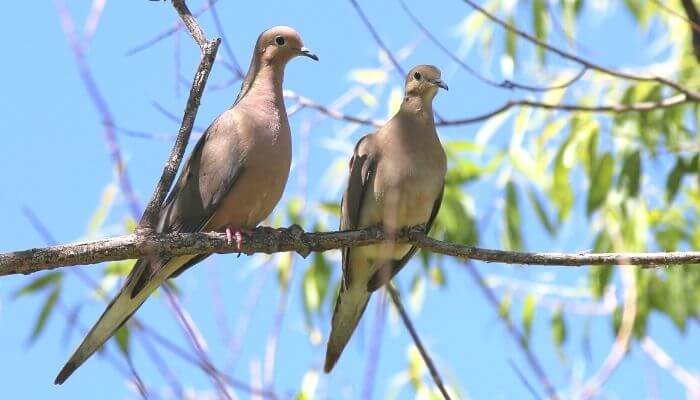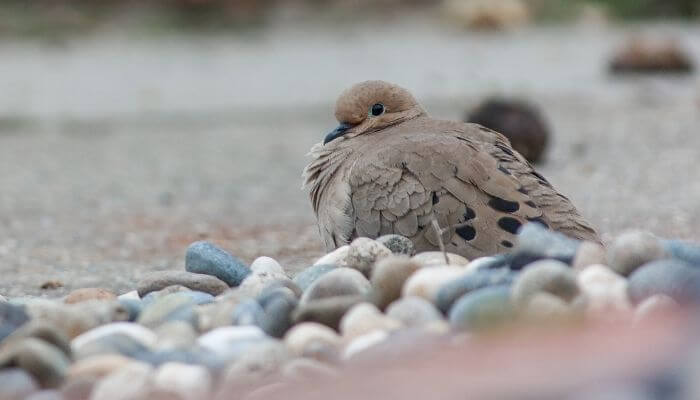The mourning dove is the most abundant type of dove in North America.
Like most of the Columbidae family, mourning doves are monogamous and mate for life.
Mourning Dove Monogamy

Like a number of other bird species, like scarlet macaws, whooping cranes and mute swans, the mourning dove mates for life.
Seeing a pair of mourning doves nestled together, almost cuddling, is one of the cutest and most common sights in bird watching.
Mating pairs are monogamous when partnered up, and in the vast majority of cases, these paired-up love birds (literally!) will be together for life.
For fans of traditional Christmas songs, the reputation for mourning doves paring up for life is reflected in the traditional 12 Days Of Christmas song.
Otherwise known as turtle doves, the second day of the song is reserved for ‘two turtle doves’, and this is a celebration of the fact the birds are monogamous and mate for life!
It sounds rather magical doesn’t it? When we think about the longevity of human relationships, we tend to think in decades, applauding those who manage to stay married for 30 years or more.
Sadly, it is not quite so romantic with mourning doves as they have a life expectancy of about two years in the wild.
If Mourning Doves Mate For Life What Happens When One Dies?
Sadly the life of the wild Mourning Dove rarely extends beyond 3 years.

However in cases where a dove dies there are a few different ways that the surviving dove may respond:
1. Caring for the deceased partner
In some cases where one partner has died, it has been heard of for the surviving dove to care for their deceased partner.
They have been witnessed attempting to care for their partner by bringing food to the corpse and routinely returning to the place where they died.
2. Mourning To Death
In some cases, it has been known for Mourning doves to literally mourn themselves to death.
Losing their lifelong partner causes great sadness and some doves have been known to literally die of a broken heart following the death of their partner.
3. Finding A New Partner
In most cases after a period of grieving the Mourning Dove will seek and find a new partner to carry on their life with.
The Courtship Ritual of the Mourning Dove
The courtship of mourning doves is much like that of the average pigeon, it begins with the male making a noisy flight which is followed by a very graceful, circular glide with their head down and wings fully outstretched.
Once landed, the male will approach the female he likes the looks of with his breast puffed out in an exaggerated manner and his head down.
This will be accompanied by a series of loud calls.
If the female likes what she sees, she will begin preening the male’s feathers, and this is something that he will reciprocate.
Once a connection is made, it is then the job of the male to lead the female to a series of potential nest sites, and the female will choose one that she feels is most appropriate. It is then the female’s job to start building the nest.
She will be helped by the male who will fly around the area, gathering suitable materials to bring to her.
The ideal dove nests are constructed from nesting materials such as twigs, blades of grass and conifer needles.
They are generally quite flimsy in construction compared to other bird’s nests.
Mating mourning dove pairs can also sometimes be quite opportunistic, and they have been known to requisition the unused nests of other mourning doves if they come across them.
On occasion, they have even been known to squat in the nests of mammals like squirrels!
A successful breeding pair will usually return to the same nest site year after year.
During the breeding and post-natal period, the parents will not range very far from the nest.
Some mourning doves are migratory with those who usually inhabit north North America migrating to spend the winter in the southern states, Mexico and Central America.
They then return north in March and April to nest.
Mourning doves who are usually resident in the southern US states tend to not be migratory and have a longer nesting season than the northern-dwelling birds who do migrate.
Wherever they end up, you can be sure they do it together, and for life!
